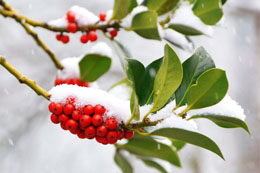Holly plants are symbolic Christmas plants. If you would like to grow some of these in your garden, then you can refer to the following article for some planting tips.

Everyone gears up to get into the holiday mood as Christmas approaches. The snow-white background is splashed with green and red. Yes, you guessed it - the green leaves and red berries of the holly plants. Hollies are a symbol of Christmas and all that is merry. Let's learn something about these plants.
Facts
Hollies belong to the plant family
Ilex. This plant family consists of over 200 varieties of English species, 120 Oriental species, and 20 American species. There are different varieties of these plants like deciduous and evergreen shrubs, bushes, as well as trees.
The size of the plant varies from 18 inches to 50 feet. There are diverse foliage colors that include green, blue, etc., and the leaves can be smooth or spiny-edged. The shape of the tree or shrub can be round, columnar, pyramidal, and even weeping. They are dioecious plant species; that means, the male and female plants are separate. You can distinguish a male holly plant from a female one by the presence of berries. Only female plants produce berries, which can be found in red, orange, black, and white colors.
Care
The most common species grown in America is the American holly that is mostly associated with Christmas festivities. If you are trying your luck with the gardening endeavor of planting a holly tree, then you need some tips that will help you grow a healthy plant.
As mentioned earlier, these plants are dioecious and therefore, you need to plant both male and female varieties. If you do not plant them close together, you will end up with a holly plant sans the berries. Berries are what make this plant attractive. Therefore, make sure you get home both varieties from the nursery. You need to plant the hollies at a distance of about 5 feet from each other. Statistically and botanically speaking, one male plant will be sufficient for five female varieties in the vicinity. Pollination will be carried out by the wind, bees, and other insects.
These plants need well-drained and fertile soil that is slightly acidic in nature. You need to plant them in a location that receives good sunlight. The hole dug to plant it should be about 2 to 3 times as wide as the root ball. Gently remove the plant from the container or nursery bag. Then, carefully place it in the hole and fill it up with soil. Water it well and allow the water to drain and again fill with water and soil.
Once you finish planting, spread a layer of compost under each tree. This step should be carried out every spring. Then mulch the plant with a 2 to 4 inch layer of pine needles, saw dust, wood chips, etc. This will keep the root system moist and cool. The plant should be watered about 1 inch per week, especially if rainfall is scanty. Pruning these plants is not always required. But if you do, try to prune them in winter, as this is the time they hibernate.
Fertilize the plant every spring or in late autumn. You need to feed them with a fertilizer that is specially formulated for acid-loving evergreen trees. When bees and other insects are successful in pollinating the females, you will soon observe red berries. This will surely make your garden look bright and cheerful.
Holly plants prove to be great for landscaping as they increase the aesthetic value of your garden. They can be sheared to form hedges as well. You need to take good care to avoid infestation or diseases. Enjoy this festive season, planting cheerful hollies in your yard.






 Everyone gears up to get into the holiday mood as Christmas approaches. The snow-white background is splashed with green and red. Yes, you guessed it - the green leaves and red berries of the holly plants. Hollies are a symbol of Christmas and all that is merry. Let's learn something about these plants.
Everyone gears up to get into the holiday mood as Christmas approaches. The snow-white background is splashed with green and red. Yes, you guessed it - the green leaves and red berries of the holly plants. Hollies are a symbol of Christmas and all that is merry. Let's learn something about these plants.